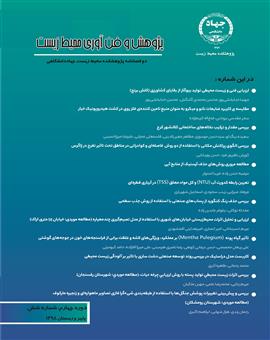Application of Drastic Model in the Studying Process of Industrial Development of Sari Plain
Subject Areas : Pollution of water resourcesMohammad rahmani 1 , tahere azari 2
1 -
2 -
Keywords:
Abstract :
New industrial estates developments must follow the effective factors in protection, management and sustainable development of aquifers and water resources in a plain in order to meet the needs of people. Therefore, assessment of the aquifer vulnerability potential for locating new industrial estates settlements is necessary. So, investigation of the vulnerability of Sari plain groundwater resources for locating the industrial zones is necessery. In this research, the risk map of the plain was prepared using a drastic model to assessment of the effective hydrogeological factors in locating the industrial estates of Sari plain. The results of the Drastic model showed that Sari aquifer vulnerability is classified in three groups of highly vulnerable (10.49%,), very highly vulnerable (56.66%) and too highly vulnerable (32.85%). Sensitivity analysis based on two-way single parameter and parameter deletion methods showed that the depth of the water-table factor is the most sensitive factor on the DRASTIC vulnerability index. Sari aquifer is strongly affected by agricultural and industrial activities' pollutants due to shallow water-table; so, the study area is not suitable for establishment of industrial estates based on the final vulnerability map, the aquifer extreme vulnerability potential and the amount of exsisting pollutant. Also, if environmental considerations are not respected by farmers and the existing industrial units in the plain, the aquifer will be suffering serious damages.
Banton, O., Villeneuve, J.P., 1989. Evaluation of groundwater vulnerability to pesticides: A comparison between the pesticide drastic index and the PRZM leaching quantities. Journal of Contaminant Hydrology, Vol. 4, No. 3, pp.285-296.
Smith, D.M. Industrial location: an economic geographic analysis.1st ed. New York: John Wiley & Sons; 1971.
Thirumalaivasan, D., Karmegam, M., Venugopal, K., 2003. AHP DRASTIC: software for specific aquifer vulnerability assessment using DRASTIC model and GIS. Environmental Modeling and Software, Vol. 18, No. 7, pp.645–656.
Bonham-Carter, G.F., Merriam D.F. Geographic information systems for geoscientists: modeling with GIS. Volume 13. 1st ed.Pergamon Press; 1995. P.416.
Hamza, M.H., Added, A., Rodríguez, R., Abdeljaoued, S., Ben Mammou, A., 2007. A GIS-based DRASTIC vulnerability and net recharge reassessment in an aquifer of a semi-arid region (Metline-Ras JebelRaf Raf aquifer, Northern Tunisia). Journal of Environmental Management, Vol.84, No.1, pp. 9-12.
Zamorano, M., Molero, E., Hurtado, A., Grindlay, A., Ramos, A., 2008. Evaluation of a municipal landfill site in Southern Spain with GIS-aided methodology. Journal of Hazardous Materials, Vol.160, No. 2-3, pp.473-481.
Sharifi, M., Hadidi, M., Vessali, E., Mosstafakhani, P., Taheri, K., Shahoie, S., 2009. Integrating multicriteria decision analysis for a GIS-based hazardous waste landfill sitting in Kurdistan Province, western Iran. Waste Management, Vol.29, No.10, pp.2740-58.
Sarcheshmeh, B., Shah Mohammadi S.h., 2017. Vulnerability assessment of Salmas plain aquifer contamination using Drastic model and GIS. Water and Soil Science, Vol.26, No.4.2, pp.55-67 (in Persian).
Arouji, B., Selgi, E., 2016. Vulnerability assessment of Asadabad plain Hamadan using geographic information system. Environmental Sciences,Vol.14, pp. 91-104 (in Persian).
Kadkhodaei-Ilkhchi, F., Asghari-moghaddam, A., Barzegar, R., Gharahkhani, M.,2019. Optimization of the Drastic and Syntax model in vulnerability assessment of Shabester plain. Iranian Journal of Eco Hydrology,Vol. 6, No. 1, pp. 77-88 (in Persian).
Aller, L., Bennet, T., Lehr, J., Petty, R., Hackett, G., 1987. DRASTIC: astandardized system forevaluating ground water pollution potentialusing hydrogeologic settings, Ada, Oklahoma: US and Environmental Protection Agency,Vol. 600, pp. 2–87.
Chitsazan, M., Akhtari, Y., 2009. A GIS-based DRASTIC Model for Assessing Aquifer Vulnerability in Kherran Plain, Khuzestan, Iran. Water Resource Management, Vol. 23, pp. 1137-1155.
Ayman, A.A., 2009. Using generic and pesticide DRASTIC GIS-based models for vulnerability assessment of the quaternary aquifer at Sohag, Egypt. Hydrogeology Journal,Vol. 17, pp. 1203–1217.
Alizadeh, A. Principles of Applied Hydrology. 21st ed. Mashhad: Imam Reza University; 2007 (in Persian).
Radmanesh, F., Sadri, S., Shahbazi, A., 2018. Evaluation of the vulnerability of the Jarmeh aquifer using DRASTIC and SINTACS methods. Journal of Water and Sustainable Development, Vol. 4, No. 2, pp. 111-120 (in Persian).
Rahman, A., 2008. A GIS based DRASTIC model for assessing ground water vulnerability in shallow aquifer in Aligarh, India. Applied Geography, Vol. 28, pp. 32–53.
Azari, T., Samani, N., Evaluation of hydrodynamic parameters and water balance of Sari-Neka plain using MODFLOW computer code. 14th Iranian Geological Society Conference and 29th Earth Sciences Conference; 2010/09/17; Urmia. Urmia University; 2010. P.20-27 (in Persian).
Lodwick, W.A., Monson, W., Svoboda, L., 1990. Attribute error and sensitivity analysis of map operations in geographical information systems: suitability analysis. International Journal of Geographical Information Systems, Vol. 4, No. 4, pp. 413–428.
Rosen, L., 1994.A study of the DRASTIC methodology with emphasis on Swedish conditions. Groundwater, Vol. 32, No. 2, pp. 278-285.
Jafari, K., Hafezi-Moghaddas, N., Mazloumi, A., Ghezi, A., 2019. Determination of vulnerability of Ardebil aquifer using DRASTIC method in GIS. Iranian Journal of Health and Environment, Vol. 12, No. 3, pp. 461-476 (in Persian).
Almasri, M., 2008. Assessment of intrinsic vulnerability to contamination for Gaza coastal aquifer, Palestine. Journal of Environmental Management, Vol. 88, pp. 577-593.
Samey, A.A., Gang, C., 2008. A GIS based DRASTIC model for the assessment of groundwater vulnerability to pollution in west Mitidja: Blida City, Algeria. Research Journal of Applied Sciences, Vol. 3, No. 7, pp. 500- 507.


